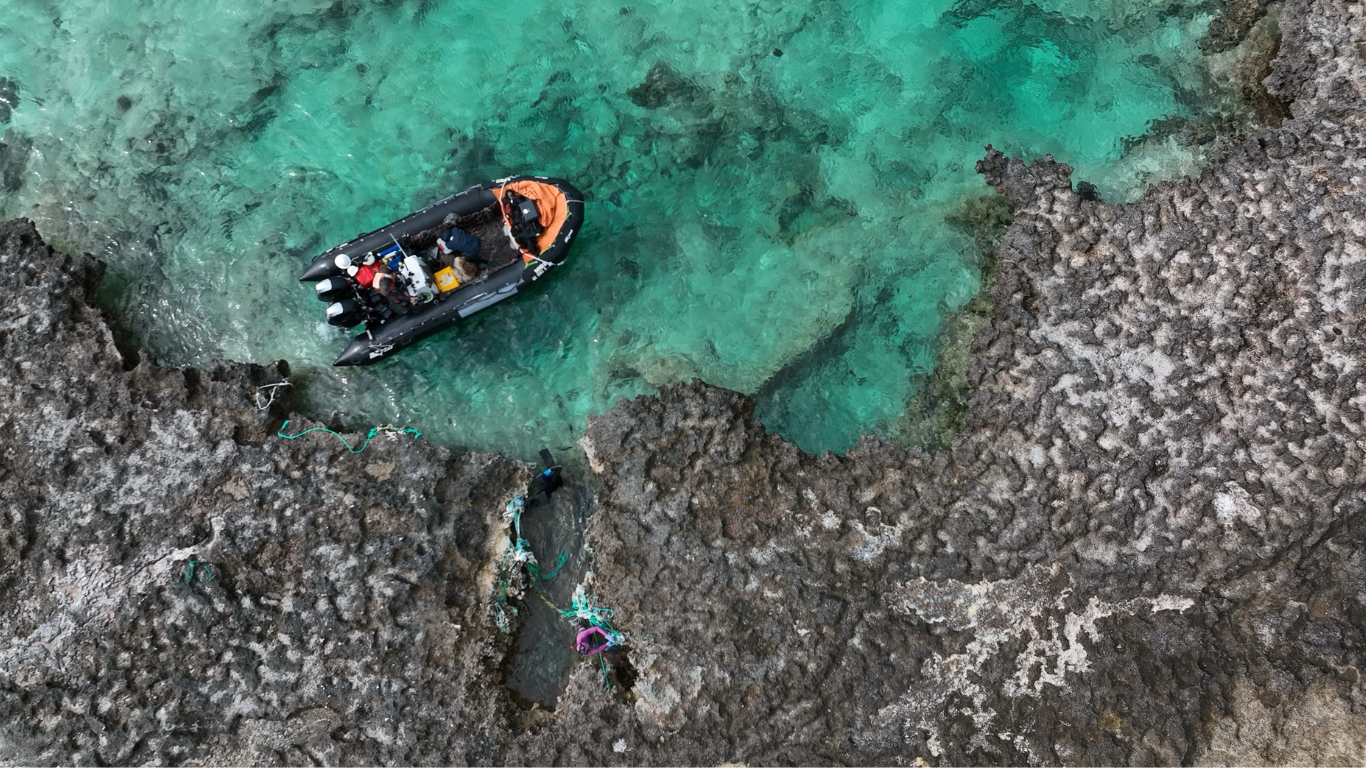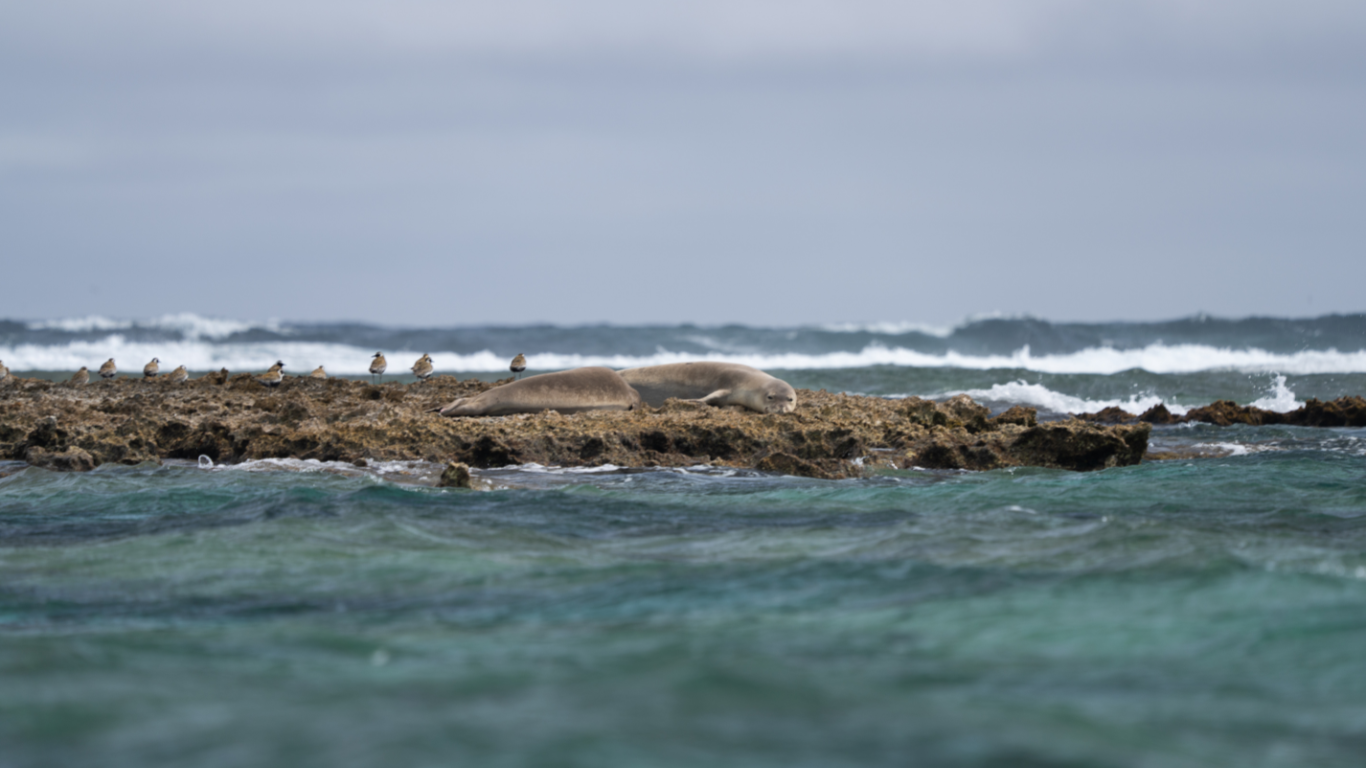Papahānaumokuākea Marine Debris Project's first big undertaking for 2025 was a 16-day fly-in, fly-out cleanup and removal mission for 2025, which ran from April 14th, 2025 – April 30th. The goal of this mission was to remove 30,000 pounds of marine debris and clean/restore 300 acres of coral reef habitat. The actual grand total? 50,730 pounds of marine debris was removed from the shorelines and reefs of Kuaihelani. Please enjoy just a few of the updates from Kevin O'Brien (President – Mission Lead), James Morioka (Executive Director), and the PMDP Team as they worked rigorously over two weeks in a massive cleanup effort. Take a look at their current and complete journey this summer on their awesome story map here.
All photos taken by Andy Sullivan-Haskins (Crew, Multimedia Specialist and Expedition Photographer for PMDP)
April 23, 2025 – Day 9
Most of the islands in Papahānaumokuākea are low, sandy and ephemeral. The ocean moves them around from year to year like a potter moves clay. Kuaihelani (Midway Atoll), for the entire duration of my adult life, has had three islands within the atoll: Sand Island, Eastern Island, and Spit Island. Sand Island is (artificially) the largest island, with all the infrastructure and a 10,000 ft runway which is kept open for transpacific emergency plane landings. Eastern Island is the second largest island, and was the primary runway during WWII, however, has been stripped of its infrastructure and has been allowed to return to a natural state. Spit Island, the smallest, was a coal depot for steamships in the early days and was separated from Eastern Island by a small channel which we deemed the “lazy river”.
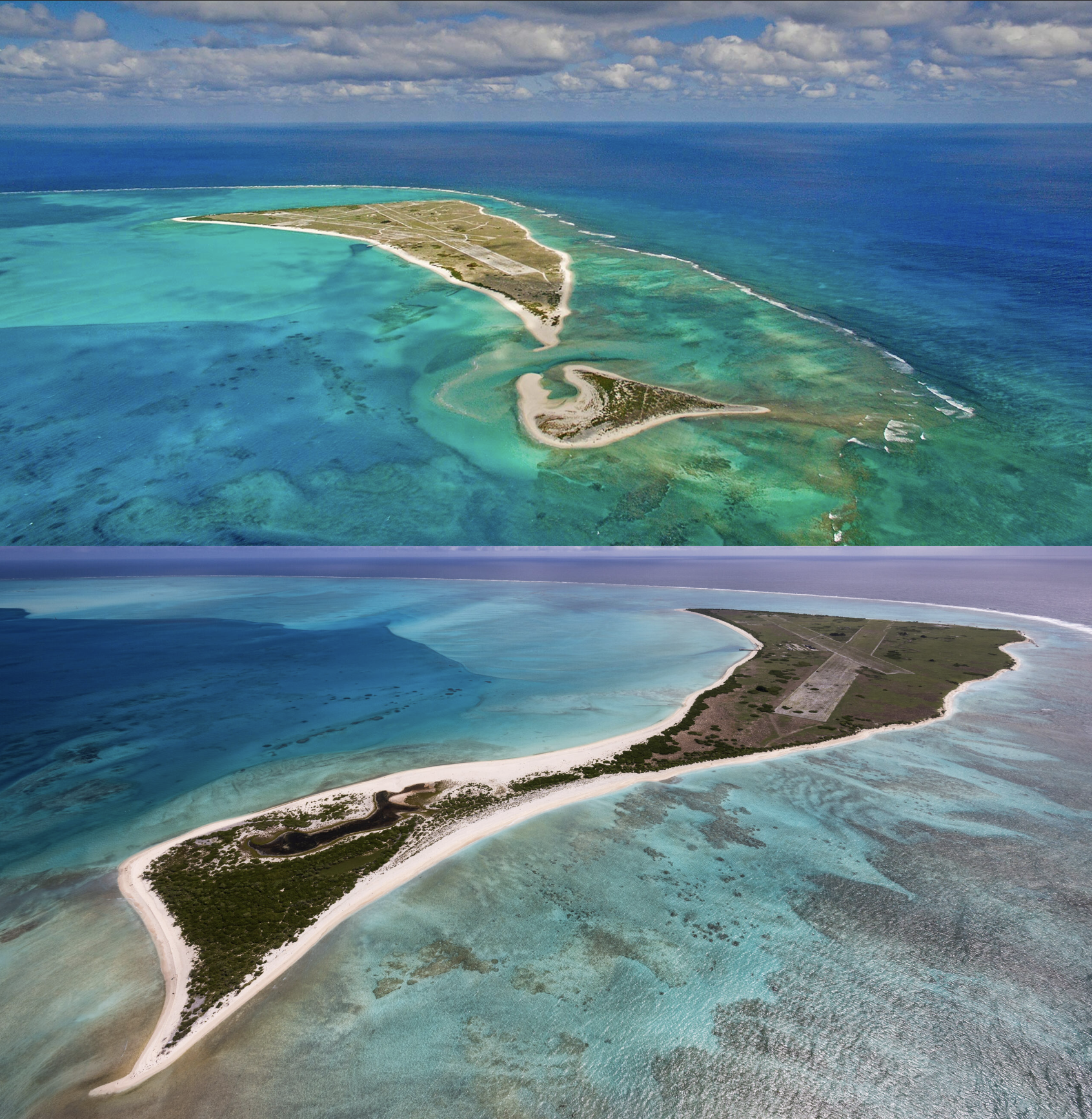
When Covid hit, we did not visit Kuaihelani for a few years, and the atoll took the opportunity to change a few things around. When we returned for the first time post-covid, Eastern and Spit Islands had joined forces. Gone was the lazy river, and the vegetation from both islands began to merge. Our long-standing NOAA shoreline accumulation plots, (300m segments which allowed us to measure annual accumulation) were thrown into chaos as the beaches blended. Today was no exception. Because we are cleaning Kuaihelani exactly 1 year since our last cleanup here, we have a unique opportunity to measure exactly 1 year of accumulation. So naturally, we resurrected the old NOAA shoreline plots, only to discover how far off they now were from reality…
New shoreline segments were required to accommodate the new shoreline, and the team soldiered on in the gray icy wind, cleaning all [the island formerly known as Spit] in one day. We were happy to note that the debris accumulation on Spit was light. This was nice, considering that many of the Hawaiian monk seal moms with new pups like to hang out there, and the primary ‘ewa'ewa (sooty tern) colony is located on Spit. With our cleanups today, that's a wrap on all Eastern and Spit Islands. We now turn our attention to Sand Island and will work to finish surveying the fringing reef in the coming days.
Mahalo to Kau'i Aguiar for more daily food-for-thought:
ʻŌlelo Noʻeau o ka lā: I kanaka no ʻoe ke mālama I ke kanaka
Translation: You will be well served when you care for the person who serves you
Blurb: This ʻŌlelo Noʻeau, reminds us that true humanity is shown through reciprocal care and respect. It emphasizes the importance of valuing those who support us and the joy of responding in kind. By nurturing others, we strengthen our communities and affirm our own humanity in the process.
ʻŌlelo o ka lā: ʻOhana
Translation: Family
Blurb: We spend a lot of time together in harsh conditions and remote places. It is natural that we develop familial relationship with one another. One of the best thing about working for PMDP is being able to collaborate with the folks who you trust and care about.
Today's Numbers:
1,730 lbs removed
-Kevin, James, and the PMDP Team
April 21, 2025 – Day 7
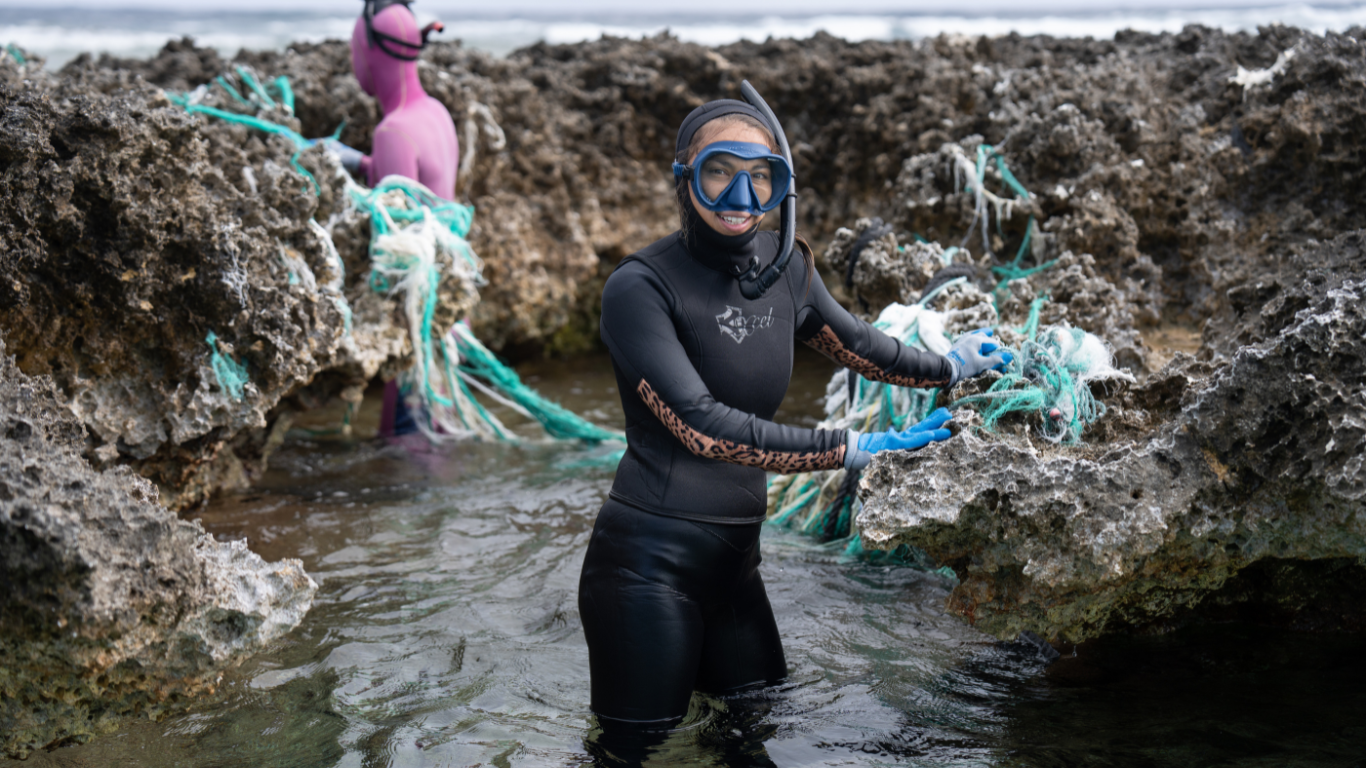
Apparently, April is still considered wintertime here north of the 28th parallel.. Today was our first day of reef cleanups since arriving at Kuaihelani, and wow. Brrrrrr. Water temps in the 60ʻs meant that our divers layered up with all the extra neoprene hoods, vests, and gloves that they had. It was gray and blustery, and the wind had a bite to it that stung your ears and nose. A constant barrage of squalls dusted us with white mist for several hours. But honestly, nothing compares to the contrast between foreboding dark clouds and brilliant turquoise water. Makes you feel like adventure. And, we had a few patches of sun too for good measure.
The barrier reef at Kuaihelani is an interesting place. Long sections of uplifted reef form “islands” of limestone that jut 6ft above the surface. Swift channels of rushing tidal water separate these islands, and have scoured deep azure pools that harbor schooling fish, cauliflower coral, macroalgae, and the ubiquitous derelict fishing nets. Swim surveys are the tool of choice to detect these nets in this dynamic environment. Today our die-hard freedivers swam for 6 hours straight in groups of four to scan a 100m swath of reef inside the surf. By the time our survey area was complete and we headed back to the harbor with 2,850lb of net, lips were blue, but the smiles were warm.
Today's ʻOlelo Noʻeau, courtesty of our scholar Kauʻi Aguiar:
‘Ōlelo No’eau o ka lā: ʻAʻohe loaʻa ika wale noho
Translation: Nothing is gained by idleness
Blurb: We braved the frigid waters of the atolls emergent reefs today. In search for net, we scoured our survey areas. Greeted by the many vibrant fish and a few friendly monk seals, the team is reminded of why we broach the icy waves and dawn the shorelines like ants; scurrying for land debris, we must leave this sacred space better then we found it.
‘Ōlelo o ka lā: Makana
Translation: Gift
Blurb: Any day we get to spend in Papahānaumokuākea is a gift. Some days are more strenuous than others, and on these particular days it is wonderful to remember that it is always an honor to take care of the place that takes care of us.
Todayʻs Numbers:
2,850 lb Net
Running Total:
21,985 lbs Removed
Until tomorrow,
Kevin, James and the PMDP Team
April 20, 2025 – Day 6
Today being Easter Sunday, naturally we gave the team a late start — 6:10 am instead of the usual 6:00 am.
There's a stretch of shoreline on Eastern Island within the remote sanctuary of Kuaihelani (Midway Atoll) where the Pacific likes to send us its worst. The north-facing lagoon beach — exposed, windswept, and wide open to prevailing winter swell and quintessential trade winds — is a natural debris magnet. Every season, it receives a delivery of heartbreak: sun-bleached plastics, drifting buoys and floats, and the biggest monster of all — derelict fishing nets.
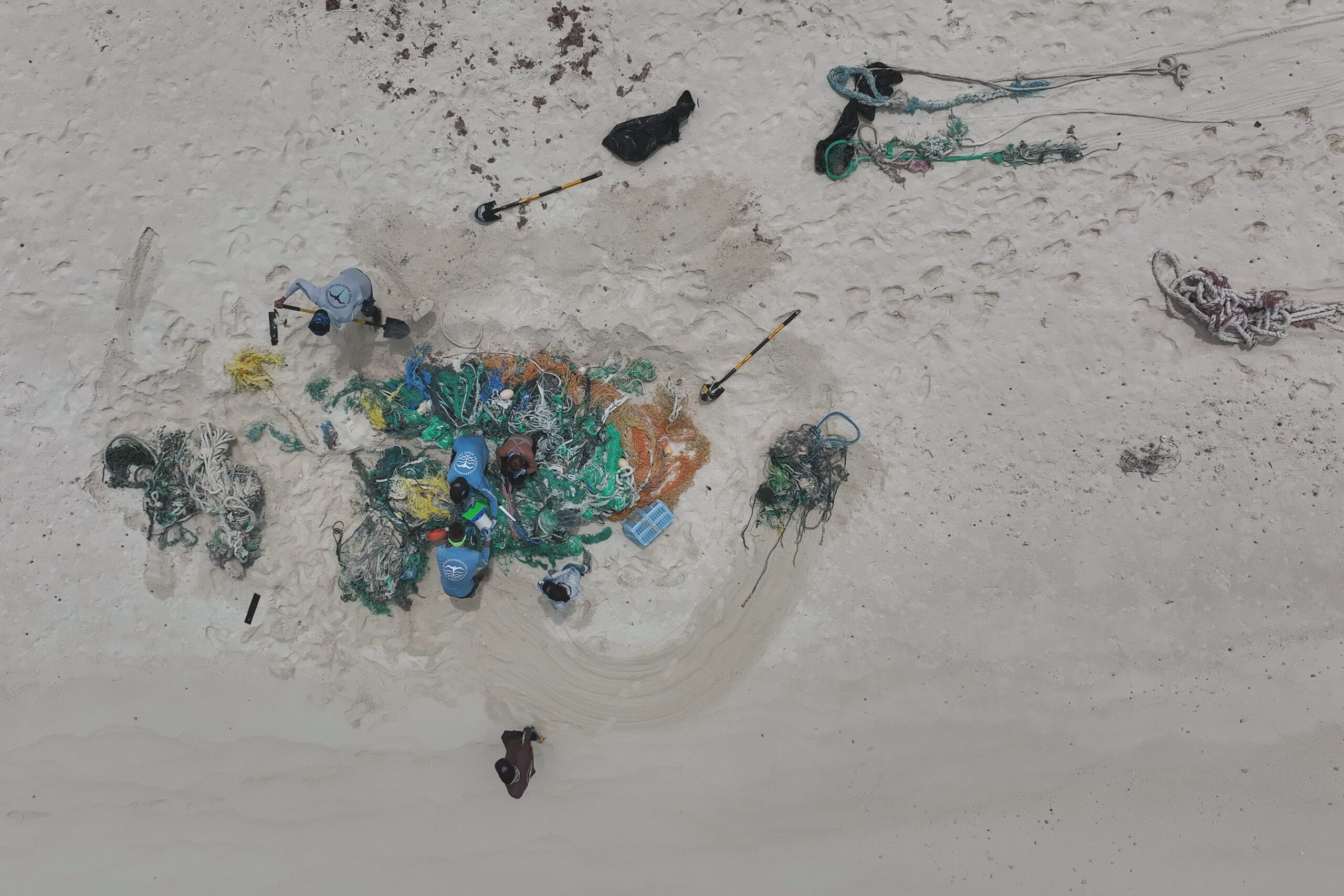
This year is no exception. Buried deep beneath the sand and coral rubble, hidden in plain sight, lay two massive ghost nets. Conglomerates of netting from various fishing industries — intertwined trawl webbing, seine nets, braided nylon, mono- and multi-filaments — weathered and weighted with time. Each of them tipping the scale at over 3,000 pounds. Tangled, taut, and buried under months of surf and sediment, they'd become a part of the shoreline itself — collecting sand, shells, and stories of a thousand tides.
Their presence was spotted by their telltale synthetic strands of green, blue, and orange poking through the surface like warning flags. Ghost gear icebergs. We knew we had a job on our hands.

We'd been preparing for a moment like this. These nets were the perfect chance to test out our new prototype cutting tool — a battery powered device designed by our Research and Development team to slice through thick, salt-hardened net fibers that eat regular tools for breakfast. The mission: break the beasts down into manageable chunks, haul them off the beach, and reroute their future — this time, to a secure storage site on Sand Island instead of back to sea.
And it worked! The tool whirred to life with promise, slicing and sputtering as it met resistance, buzzing through the bulk of tangled mesh with a satisfying growl. It turned what once felt immovable into something liftable. The prototype gave us hope. One small cut for marine debris, one giant step for PMDP.
But even the best tools have limits. And what can you always count on to get the job done? The same thing that always has. A team of salty, sunburnt marine debris technicians armed with sharp serrated bread knives and sharper instincts. Precision cutters, part field scientist, part surgeon, our team moves with methodical purpose — severing one tangled limb at a time, until the existence of the monster net becomes a memory of the past.
There's something poetic about it — how, despite all the tech and innovation, it's still human hands and perseverance that make the difference. Still teamwork. Still sweat. Piece by piece our team hoisted net sections onto their shoulders, forming human chains to shuttle debris to the boats waiting just offshore.
It took determination. It took sore backs. But at the end of the day, 8,420 pounds of debris were off the shoreline and out of harm's way.
This beach will see more nets. It always does. But for now, the monsters are gone, and the monk seals, sea turtles, and seabirds of Eastern Island can breathe a little easier.
Because while the tools keep getting better, nothing beats a good knife and a team that knows how to use it.
For those of you keeping score at home: 19,135 pounds removed. And counting.
From Kauʻi Aguiar:
‘Ōlelo No’eau o ka lā: He luelue ka ʻupena e kuʻu ai
Translation: The fine-meshed net is the one to let down into the sea.
Blurb: We work well to make sure we expel debris both big and small. Today, on the shores of the Eastern Island of Kuaihelani, the PMDP crew were like ʻupena and “caught” nearly 9,000 lbs of trash. We are eager for another day!
‘Ōlelo o ka lā: Mālama
Translation: To take care
Blurb: We have finished our fifth consecutive day of operations here, on Kuaihelani. In order to mālama this place as best as possible we must first mālama each other. As the mission continues we will continue to clean with love and intention!
Kevin, James and the PMDP Team
April 15-18, 2025 – Days 1 to 4
Welcome to the first nightly update of PMDP's first large-scale field cleanup mission of the year! For the next two weeks, the PMDP team will be living on Kuaihelani (Midway Atoll) and conducting an atoll-wide cleanup of both reefs and beaches.


This is the second year in a row that we've focused an entire cleanup mission on just Kuaihelani. The reason? It's a pretty dirty place, despite everyone's best efforts. Last year, two weeks of cleanup yielded 70,000 lbs. Now we've returned exactly 1 year later and are hoping to capture some data to show how much net and plastic accumulate annually here at Kuaihelani. This will give us a better idea of how much effort we need to dedicate to this atoll in coming years to keep up with annual accumulation. We're very happy to be here and very grateful for our wonderful partners at the US Fish and Wildlife Service who have helped facilitate our visit (Mahalo to Refuge Manager Elaine Johnson, biologists Morgan Walter, Jon Plissner, Tammy Summers, Caroline Pott, and all the other wonderful staff at Midway Atoll National Wildlife Refuge and Battle of Midway National Memorial and Chugach Corp).
Kuaihelani is the only location in Papahānaumokuākea that has permanent habitation and is accessible by plane. Because we donʻt need a ship to access Kuaihelani, this monthʻs cleanup is our most cost-effective yet. Back in February, we palletized our boats, engines and survey gear, packed it in a shipping container and sent everything up on to Kuaihelani on the quarterly USFWS supply ship so it was waiting for us when the first half of our team arrived via plane on Monday. The next two days were spent unrolling and inflating our boats, hanging outboard engines, setting up our mobile dive locker, scouting for debris accumulation and cleaning two of the more accessible beaches. We've now been here four days. Why is this our first nightly update, you ask? Well, itʻs been a whirlwind. Our arrival to Kuaihelani just happened to coincide with the submission deadline of a large and important grant proposal (for an exciting coastal restoration project at Lalo (French Frigate Shoals)), so all our evening hours for the past few days were spent finalizing our proposal. But, now thatʻs been submitted and the boats are up and running, weʻre off to the races and youʻll be hearing from us daily.
Yesterday the second half of our team arrived and we simultaneously said goodbye to three wonderful partners who had joined us for two days (Pīkake Kuniyoshi, of the Papahānaumokuākea Cultural

Working Group, Dr. Mark Hixon of the Papahānaumokuākea Reserve Advisory Council, and Sara Wood, representative of the NOAA National Monument Office) Mahalo for joining us and for working so hard on cargo beach! After our newly-arrived team received their island orientation, they managed to get in a few hours of shoreline cleanup which resulted in the salvage of a derelict vessel that had washed in and become buried in the surf on the north beach of Sand Island. Today was our first full day of ops, and the team jammed out a linear mile of shoreline cleanups on Eastern Island which yielded 5,525 pounds… Our 12-person crew are all returning team members with several years of experience, so this is a well-oiled machine that has just begun to spin up.
Each day while we are in Papahānaumokuākea, our team learns ʻOlelo Noʻeau (Hawaiian proverbs or poetical sayings) and a word-of-the-day to help the team connect with the place and the culture that is inseparable from this landscape. We thought it would be great to share these with you from time to time in these nightly updates.
Today's learnings, brought to you by our all-star 3rd year teammate Kauʻi Aguiar:
‘Ōlelo No’eau o ka lā: “He Ali’i ka ‘āina; he kauwā ke kanaka”
Translation: The land is chief; man is it’s servant
Blurb: Today marks our first full day of operations on Kuaihelani. Each time we have the privilege of working in Papahānaumokuākea the passion for serving this place is evident. It is our love for our home and the reverence we hold for it that brings us together each year to serve this land in the best ways we know how.
‘Ōlelo o ka lā: “Ho’omau”
Translation: To be persistent, to be constant
Blurb: From sunrise to sunset, the PMDP crew embodies ‘Ho’omau’ in all aspects of the job. It is the perseverance and the persistence that we ask of ourselves and encourage in each other, that make what we do possible.
Aaaand finally, the reason weʻre out here doing what we do:
The Numbers
Day 3: 1,780 lbs derelict vessel (panga fishing boat)
Day 4: 5,525 lbs total
- 4,165 lbs Net
- 1,360 lbs Plastics
Running Total:
7,305 lbs
Mahalo,
Kevin, James and the PMDP Team

